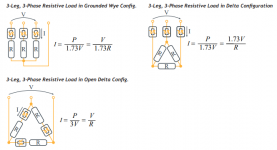Since the phase current within a delta-connected configuration is 1.73 times less than the line current, it seems like there would be significant cost savings to locating large power control equipment in the delta circuit, such as contactors and SCR power controllers (in this case, assume it's a three-phase resistive load). It would be the difference between the top right and bottom left configurations below:

The circuit would need twice the number of conductors from the panel housing the power control equipment to the resistive load, however those conductors could be smaller as long as a circuit breaker rated for the reduced current was used in the delta circuit. Also, based on tap rules, would there need to be a circuit breaker on both sets of conductors in the delta circuit? Are there any other concerns (including regulatory based on NEC or UL-508A) with designing a power control circuit in this manner?

The circuit would need twice the number of conductors from the panel housing the power control equipment to the resistive load, however those conductors could be smaller as long as a circuit breaker rated for the reduced current was used in the delta circuit. Also, based on tap rules, would there need to be a circuit breaker on both sets of conductors in the delta circuit? Are there any other concerns (including regulatory based on NEC or UL-508A) with designing a power control circuit in this manner?

